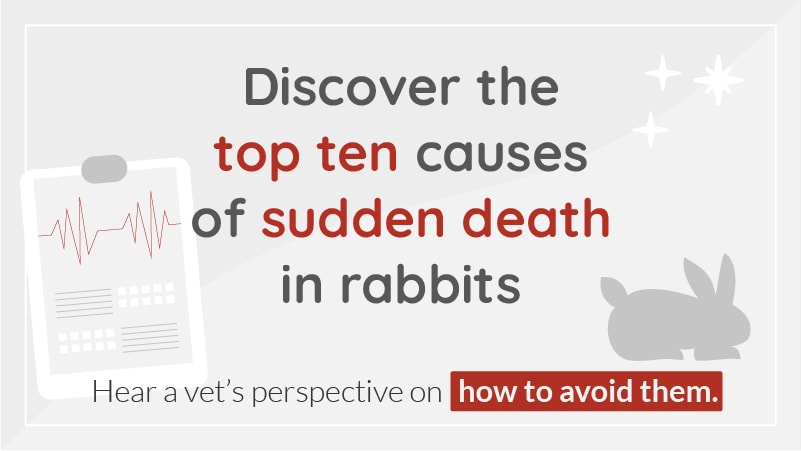Until recently, there simply wasn’t enough data to draw conclusions about certain aspects of pet rabbit health – at least, not in the way we can about dogs and cats.
However, as rabbits are an increasingly popular pet worldwide, more information is becoming available about the prevalence of various illnesses and causes of death.
Several large-scale scientific studies published from 2015 onwards are illuminating the causes of premature pet rabbit deaths. As more information is available from around the world, we are starting to gain a comprehensive understanding of this issue.
In this guide, we break down the scientific findings to bring you clear, evidence-based statistics on sudden death in pet rabbits, including why it happens and what can be done to prevent it.
Top 10 Statistics on Sudden Death in Rabbits
Sudden deaths in pet rabbits can be due to a fast-acting disease or injury, such as viral RHD and myxomatosis, fly strike, or heatstroke.
An apparently sudden death can also occur when an asymptomatic condition that has been present for some time suddenly gets worse, such as cancer or parasitic disease.
Here are some key statistics that bunny owners should know about sudden death in rabbits:
1. 90% of rabbits who contract Rabbit Hemorrhagic Disease die within 36 hours
2. Some strains of myxomatosis kill up to 99% of infected rabbits
3. Cancer is responsible for 25% of deaths in rabbits aged 5 years and above
4. Overheating in a hutch kills 15% of pet rabbits
5. One in six rabbit sudden deaths is due to gastrointestinal (GI) stasis
6. Myiasis, or fly strike, causes 11% of sudden deaths in rabbits
7. Encephalitozoon cuniculi is the cause of 9% of rabbit deaths
8. 5% of rabbits die from injuries and trauma
9. Cardiac diseases, including heart attack, are responsible for 3% of rabbit deaths.
10. More than 30 species of plant in our houses and gardens, as well as numerous household chemicals, can be lethal to rabbits.
As prey species, rabbits have evolved to hide any symptoms of illness. A survey of 167 apparently healthy rabbits found that 71% had abnormalities on clinical examination or x-rays [1]. Often by the time we find out about them, it’s too late.
Let’s look at each of these facts in more detail, to see what the science says, and what owners can do to protect their pet rabbits.
1. Rabbit Hemorrhagic Disease (RHD) is a leading cause of sudden death in rabbits, with a mortality rate of 90%
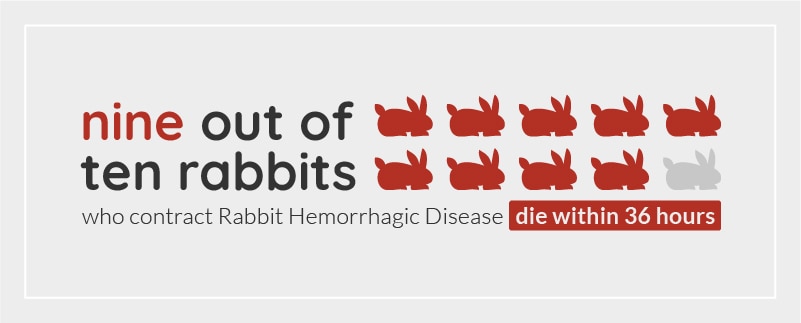
RHD has been a problem in various countries for years, but it was first detected in wild rabbits in the US in 2020 and has been spreading rapidly. By 2022, the disease had been confirmed in wild rabbits across 11 states, and domestic rabbits in a further 8 states. Cases have been rising in 2023, particularly in Texas, where the public is asked to contact the Wildlife Department if they see dead wild rabbits.
The rabbit hemorrhagic disease is caused by three strains of calicivirus called rabbit hemorrhagic disease virus (RHDV) [2]. The mortality rate due to RHD can reach 90% within 36 hours, with sudden rabbit death being the most common outcome of this disease [3].
The virus may pass directly through contact between rabbits, or indirectly. This includes if there is contamination of the rabbit’s environment with blood or urine from an infected rabbit, or even if flies feed on a carcass and then settle in the area the pet rabbit has access to.
Infected rabbits do not usually show signs of disease, but if they do, common symptoms include high temperature, bleeding from the nose or mouth, anorexia, lethargy, elevated respiratory and heart rate, seizures, and signs of liver failure like jaundice.
RHD Prevention
The best way to protect rabbits against RHD is by vaccination, which can often be given from 5 or 6 weeks of age, depending on the brand. This should be followed by an annual booster.
As there are three different strains of RHD, check with your vet whether your rabbit has been protected against the latest strains circulating in your area.
If you have a new bunny joining your family, it’s a good idea to quarantine them for 14 days to check for signs of illness, before letting them mix with your rabbits.
2. Myxomatosis can kill up to 99% of infected rabbits, and there is no vaccine in the US
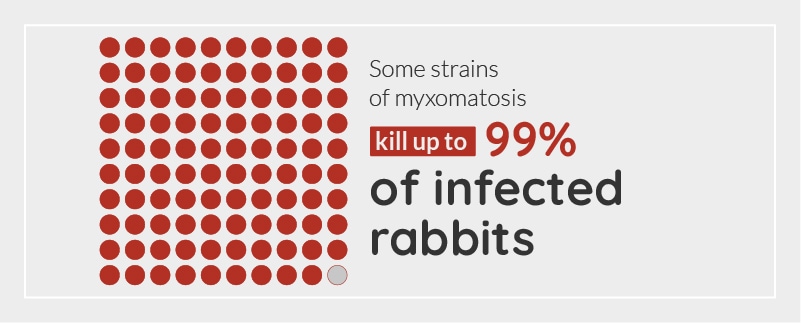
Myxomatosis is a pox virus that causes sudden death in rabbits and hares. It was introduced intentionally to control wild rabbit populations, the virus is now endemic across Europe, North America, South America, and Australia. Myxomatosis is listed in the World Organization for Animal Health (WOAH) Terrestrial Animal Health Code, which means that countries are expected to report myxomatosis outbreaks to the WOAH [4].
Myxomatosis is transmitted by fleas and mosquitoes. These ingest the virus when they bite an infected animal, and then transmit it when they later bite a non-infected animal. The virus may also spread directly from animal to animal or via contaminated objects.
The disease is characterized by swellings and lumps on the face and limbs of infected rabbits, but some strains are so virulent that the rabbit dies before symptoms develop. Studies show that viral diseases, including myxomatosis, cause about 12% of rabbit deaths [5]. Although there is a vaccine against myxomatosis in the UK, it has not been approved for use in the US.
Myxomatosis Prevention
As there is no treatment for myxomatosis, and currently no vaccine available in the US, prevention is absolutely key. Take steps to eliminate fleas and mosquitoes from your rabbit’s environment, including using veterinary-approved rabbit flea treatments at precise intervals. If you suspect one of your rabbits has caught myxomatosis, be sure to quarantine them from your other rabbits to prevent the spread of infection.
3. Neoplasms or cancers cause 1 in 4 deaths in rabbits aged five and above
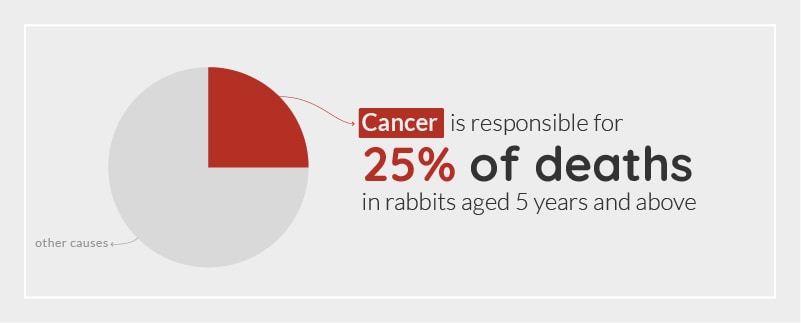
Cancers or neoplasms become an issue as rabbits age, and are a leading cause of death in older bunnies. According to a study published in the Journal of Exotic Pet Medicine in October 2022, neoplasms account for 25% of deaths in rabbits aged five and above [6]. Another study attributes 5% of rabbit deaths across all ages to neoplasms [5].
It may seem counterintuitive for cancer to appear on a list of causes of sudden death, as they take a while to develop. However, rabbits are skilled at hiding signs of pain, and sometimes there are no obvious symptoms until their system collapses.
Uterine adenocarcinoma is the most common cancer in female rabbits, occurring with an incidence of 50%. It is a serious health risk to unspayed rabbits aged two and above. Mammary adenocarcinoma is another common neoplasm in rabbits. According to a study, mammary tumors constituted 20% of samples of pet rabbits submitted for microscopic examination to a diagnostic laboratory in Germany [7].
Clinical signs of uterine cancer in rabbits include a spot or pool of blood in the urine. Swollen and firm mammary glands with enlarged and discolored teats are also observed in the case of tumors of the mammary gland.
Cancer Prevention in Rabbits
Spaying or neutering a rabbit is the best way to prevent reproductive cancers in rabbits, as well as eliminating the possibility of unplanned offspring.
According to the People’s Dispensary for Sick Animals (PDSA), owners are more likely to get male rabbits neutered than females, and only 50% of female pet bunnies are spayed [8]. Take your rabbit for regular check-ups with your vet, so any abnormalities can be detected early.
4. Heatstroke is the cause of 15% of sudden deaths in pet rabbits
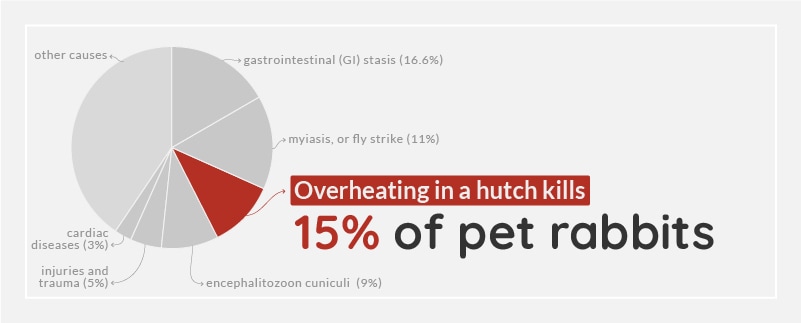
Rabbits are very sensitive to thermal stress, and one study found that 14.7% of sudden deaths in pet rabbits can be attributed directly to heatstroke [5].
Heatstroke is a condition in which a rabbit’s body overheats due to high environmental temperature. A rabbit’s normal body temperature is between 101 and 103 °F (38.5–39.5 °C), and they struggle to cope if their body temperature rises to 105 °F (40.5 °C). Heatstroke progresses quickly and is considered a medical emergency, often resulting in seizures, organ damage, and death.
Rabbits can develop heat stroke if they are trapped in a hot room or in a small hutch, especially on hot days. Obese, pregnant, very young baby rabbits and old rabbits are especially prone to heatstroke.
According to a study published in the Frontiers in Veterinary Science journal, being stuck in a hot environment causes heat stress in rabbits, which suppresses immune function, causes oxidative stress, and can increase mortality rate by 9 to 12% [9].
Heatstroke Prevention
Keep rabbits in a cool room during summer, and always provide them with enough space that they can move to a cooler area if they need to. If your rabbit shows signs of heatstroke, cool it down by wetting its ears, or soaking it gently with a wet towel, and take it to the veterinary clinic immediately. Never cool a rabbit by immersing it in water, or by using alcohol on its skin, as this may cause the rabbit to go into cardiac arrest.
5. One in six of rabbit deaths are due to gastrointestinal stasis
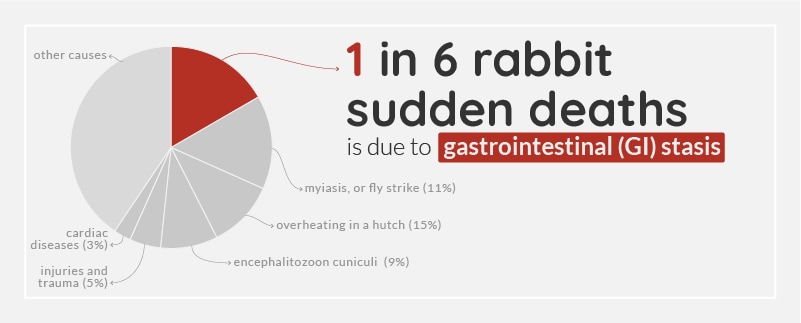
Gastrointestinal (GI) stasis is a common, life-threatening condition in which the motility of the rabbit’s digestive system slows down or stops completely. While some studies have found GI problems cause 9% of all rabbit deaths, others estimated up to 15%, with an even higher proportion in rabbits under 4 years old [6, 10].
GI stasis often occurs due to an inappropriate diet. This is a common problem, and it is estimated that 3 in 10 pet rabbits are not fed enough hay [8].
The other main reason is if the rabbit stops eating, because of stress, dehydration, and pain from underlying illnesses like dental problems and urinary tract infections. These conditions are not rare: for example, it is estimated that between 30 and 40% of rabbits have significant dental disease [1, 11].
When rabbits stop eating, their gut activity slows or stops. Anorexia alone is reported to cause about 5% of rabbit deaths, and about 13% of rabbits taken to the vet have a reduced appetite [10, 12]. A decrease in appetite followed by a corresponding decrease in fecal production is one of the key signs of GI stasis. Other symptoms include signs of pain, lethargy, and a hunched posture.
GI Stasis Prevention
Providing rabbits with an appropriate diet is the most important step to prevent GI stasis. The ideal rabbit diet should be fiber-rich, hay-based, and contain a few pellets and vegetables. Along with the right foods, provide adequate fresh water.
GI stasis is a life-or-death emergency. If you notice that your rabbit is eating less or passing fewer fecal pellets, take them to your veterinarian immediately.
6. Almost 11% of rabbit deaths are due to fly strike
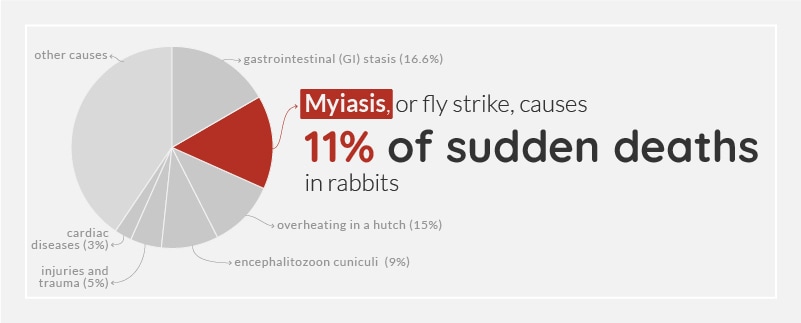
Myiasis is caused by flies, typically blue bottle and green bottle flies, which lay their eggs on the rabbit’s skin near injuries, fur mats, or fecal soiling. The maggots eat the rabbit’s flesh within 24 hours of hatching, causing pain and sudden death.
A study on the causes of morbidity and mortality in UK pet rabbits found that 10.9% of rabbit deaths could be attributed to fly strike [10]. The risk of fly strike increases by 33% for every one-degree Celsius rise in temperature between 40.5.°F (4.7 °C) and 63.9 °F (17.7 °C) [13].
Myiasis is often associated with fecal soiling, either due to gastrointestinal upset or the rabbit struggling to keep themselves clean, and data from vet clinics shows that the perineal region accounts for 52% of fly strike cases [13]. Two further risk factors for fly strike – matted fur and obesity – are found in 7% and 10% respectively of rabbits examined by veterinarians [12].
Clinical signs of myiasis include rapid breathing, reluctance to move, and extensive soft tissue damage. Toxins flood the body and it can quickly lead to death.
Fly Strike Prevention
The most important thing you can do to prevent your rabbit from dying of fly strike is to check their bottoms are clean. Once a day may be enough in the cooler months, but you should check them morning and night in the hot weather.
If your rabbit has urine or fecal soiling around their bottom, you can clean it gently with warm water, or take them to your veterinarian. Your vet can also help ascertain what is causing the soiling, so that the underlying problem can be addressed.
Use a fly strike treatment during the summer. While it does not stop flies from perching on rabbits, it does prevent the maggots from hatching.
7. Encephalitozoon cuniculi causes nearly 1 in 10 rabbit deaths
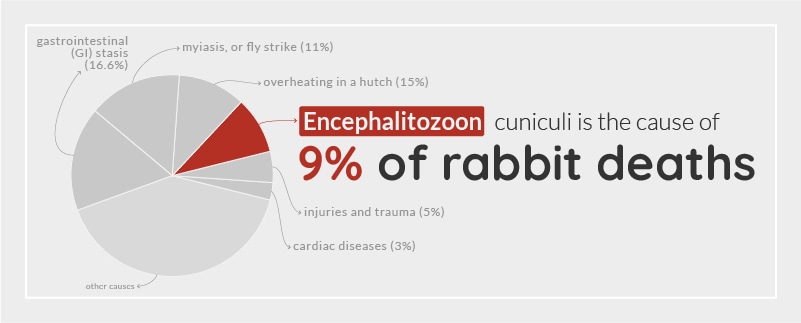
E. cuniculi is a parasite that lives inside cells and affects the brain, nerves, and kidney of rabbits. In a study of causes of sudden death in wild, farmed and pet rabbits, E. cuniculi was responsible for 9.4% of deaths overall, and up to 18% of deaths in pet rabbits [5].
E.cuniculi is transmitted by ingestion of food contaminated by urine from an infected rabbit, and it can even be passed from a mother to her unborn babies. It is widespread in the pet rabbit population, and 23% of apparently healthy rabbits have antibodies against E. cuniculi, showing they’ve been exposed at some point in their lives [14].
Most rabbits show no signs of the disease, but if they do, common symptoms include head tilt, seizures, anorexia, inability to stand on four legs, white plaques in the eyes, eye twitch, and weight loss.
E. Cuniculi Prevention
Rabbits catch E. cuniculi from the urine of infected rabbits, so prevention relies on keeping them away from rabbits carrying the parasite. From antibody tests, vets have worked out that a rabbit has a 66% chance of being exposed to E. cuniculi if they live with a rabbit who has the infection [14]. If you are bringing a new rabbit into the group, ask your vet for a course of anti-parasitic medication to clear any E. cuniculi they might be carrying and prevent it from causing illness or passing to your other bunnies.
8. Nearly 5% of deaths in rabbits are caused by trauma
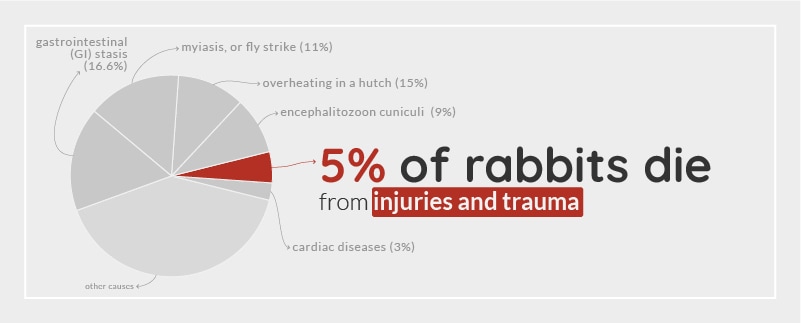
According to a study on the causes of nearly 900 rabbit deaths, trauma was responsible for 4.9% [6]. Rabbits may be injured by predators, by other rabbits during fights, or by rough handling.
While some of these injuries can cause the rabbit to collapse within a few hours, in other cases the injuries may go undetected for a few days while the rabbit’s system slowly deteriorates. The PDSA have identified that 21% of rabbit owners spend no time interacting with their pets, which increases the likelihood of trauma being missed [8].
Injury and Trauma Prevention
Ensure that anyone who handles your rabbit is capable of handling them properly, to reduce the risk of injury. Strengthen your bond with your rabbit with regular grooming, which also gives you a chance to check them from head to toe and notice any injuries or abnormalities. Consult a veterinarian immediately if a rabbit is injured.
Rabbits are not really a children’s pet, and even as adults it’s easy to handle them wrong and risk them injuring themselves when they jump. Ask your veterinary team or an experienced rabbit owner to help you master safe handling methods, so that you can pick up, hold, check, and put down your rabbit confidently and safely.
9. 3% of rabbit deaths are from cardiac problems, including heart attacks
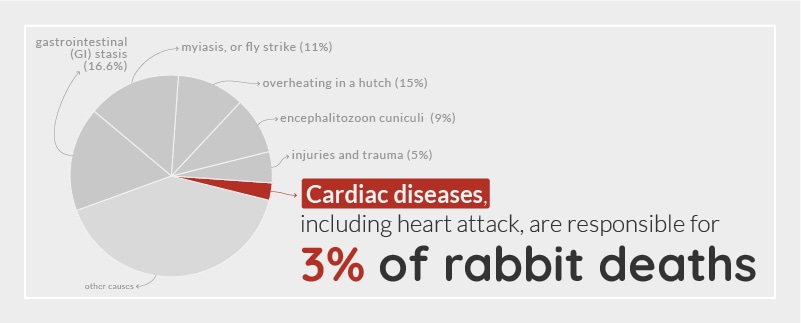
Cardiac diseases, including fear-related heart attacks, account for 3% of rabbit deaths [6]. Rabbits are prey animals and, as a result, most are easily frightened by loud noises and other surprises [15]. Even a healthy rabbit can experience this if exposed to aggressive dogs or cats. Susceptible rabbits become so scared that they go into shock and suffer sudden death a few days later.
The fear-related heart attack is a component of exertional or capture myopathy [16]. This is a disorder that results from the intense stress of being chased or captured by a predator – and some rabbits experience this when being held by a human. It is common in both pet and wild rabbits, and although there’s usually no sign of disease or injury, the rabbit suddenly dies.
Clinical signs of capture myopathy include increased respiratory rate and heart rate, as well as an increase in body temperature.
Rabbit Heart Attack Prevention
Loud noises, loud music, screaming, and the presence of predators can all cause a rabbit to go into shock., so keep your rabbit’s living area calm and quiet, away from other animals like dogs and cats. Playful children under 12 years of age may also scare rabbits, so it’s best to keep rabbits away from them.
10. At least 30 species of common plants are toxic to rabbits
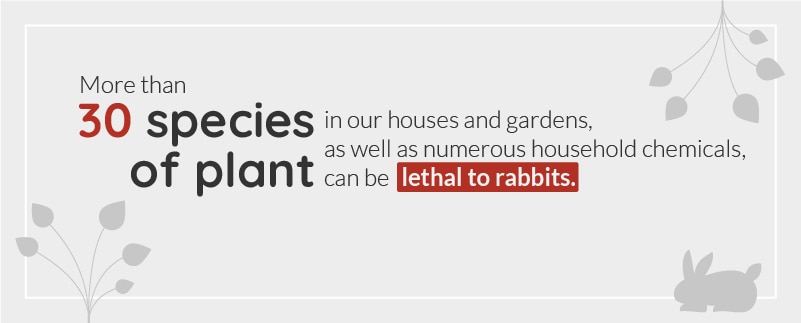
While leafy greens are good for rabbits, there are a number of houseplants and garden plants like foxglove, ivy, and rhubarb that are toxic to rabbits. Some sources have more than 30 species on the toxic list, while others recommend that all houseplants should be considered poisonous to rabbits and avoided [17, 18].
Certain household substances can also be very toxic to rabbits when ingested. The same goes for glyphosate herbicide products, outdoor and indoor insecticides, rat poison, human food and medicine, as well as cat or dog flea treatments.
Usually, rabbits show no signs of poisoning until there has been a build-up of the toxin, making treatment difficult. Clinical signs of poisoning in rabbits include hunched posture, abdominal pain, diarrhea, breathing difficulties, seizures, refusal to eat or drink, high or low temperature as well as internal or external bleeding.
Prevention
As rabbit owners, we need to ensure our bunny’s environment is safe, which includes fencing off potentially toxic plants and keeping houseplants and chemicals out of reach.
Keep rabbits away from all house or garden plants, as well as surfaces or plants sprayed with herbicides or insecticides. Additionally, never apply cat or dog flea products to rabbits. If you suspect a rabbit has been poisoned, consult a veterinarian immediately.
Conclusion
There are numerous causes of sudden deaths in rabbits, and many are preventable with preparation and careful observation. A rabbit’s secretive nature means they often hide symptoms of illness until it’s too late, so spending time with your rabbit daily and checking them thoroughly can help you detect early symptoms. Speak to your veterinarian about the most appropriate preventative medicines for your rabbit, based on the diseases that are common in your area.
If you have found this article useful, share it with your fellow rabbit owners. If you have any questions about sudden deaths in rabbits, leave them in the comments section below.
References
- Mäkitaipale J et al. “Health survey of 167 pet rabbits (Oryctolagus cuniculus) in Finland.” Vet Rec. 2015, 177(16):418. doi:10.1136/vr.103213.
- Harcourt-Brown N et al. “RHDV2 epidemic in UK pet rabbits. Part 1: clinical features, gross post mortem and histopathological findings.” J Small Anim Pract. 2020, 61(7):419–427. doi:10.1111/jsap.13141
- Kerr P, Donnelly T. “Viral Infections of Rabbits”. Vet Clin North Am Exot Anim Pract. 2013, 16(2):437–468. doi:10.1016/j.cvex.2013.02.002.
- World Organization for Animal Health (WOAH). “Myxomatosis”. Retrieved March 14, 2023.
- Espinosa J et al. “Causes of Mortality and Disease in Rabbits and Hares: A Retrospective Study.” Animals (Basel). 2020, 10(1):158 doi:10.3390/ani10010158
- Shiga T et al. “Age at death and cause of death of pet rabbits (Oryctolagus cuniculus) seen at an exotic animal clinic in Tokyo, Japan: a retrospective study of 898 cases (2006–2020)” J Exotic Pet Med. 2022, 43:35–39. doi: 10.1053/j.jepm.2022.09.003.
- Baum B, Hewicker-Trautwein M. “Classification and Epidemiology of Mammary Tumours in Pet Rabbits (Oryctolagus cuniculus)” J Comp Pathol. 2015. 152(4):291–8. doi: 10.1016/j.jcpa.2015.01.009
- People’s Dispensary for Sick Animals (PDSA). “PAW Report 2022”. Retrieved March 14, 2023.
- Liang Z et al. “Impacts of Heat Stress on Rabbit Immune Function, Endocrine, Blood Biochemical Changes, Antioxidant Capacity and Production Performance, and the Potential Mitigation Strategies of Nutritional Intervention” Front Vet Sci. 2022, 9:906084. doi: 10.3389/fvets.2022.906084
- O’Neill D et al. “Morbidity and mortality of domestic rabbits (Oryctolagus cuniculus) under primary veterinary care in England.” Vet Rec. 2020, 186(14):451. doi:10.1136/vr.105592.
- Mullan S, Main D. “Survey of the husbandry, health and welfare of 102 pet rabbits”. Vet Rec. 2006, 159(4):103–9. doi: 10.1136/vr.159.4.103.
- Robinson N et al. “Investigating common clinical presentations in first opinion small animal consultations using direct observation”. Vet Rec. 2015, 176(18):463. doi:10.1136/vr.102751.
- Turner R et al. “Risk factors for cutaneous myiasis (blowfly strike) in pet rabbits in Great Britain based on text-mining veterinary electronic health records.” Prev Vet Med. 2018, 153:77–83. doi: 10.1016/j.prevetmed.2018.03.011
- Harcourt-Brown F, Holloway H. “Encephalitozoon cuniculi in pet rabbits”. Vet Rec. 2003, 152(14):427–31. doi: 10.1136/vr.152.14.427.
- Rooney N et al. “The current state of welfare, housing and husbandry of the English pet rabbit population” BMC Res Notes. 2014, 7:942. doi: 10.1186/1756-0500-7-942
- Breed D et al. “Conserving wildlife in a changing world: Understanding capture myopathy—a malignant outcome of stress during capture and translocation” Conserv Physiol. 2019, 7(1):coz027. doi: 10.1093/conphys/coz027
- Apex Vets. “List of Poisonous Plants for Rabbits”. Retrieved March 14, 2023.
- Rabbit Welfare Association & Fund (RWAF). “Poisonous Plants”. Retrieved March 14, 2023.


